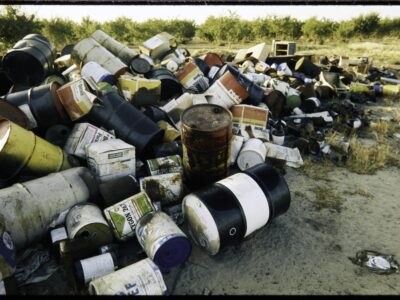Happy 50th Anniversary, Federal Clean Water Act
One of America’s Foundational Environmental Laws Has Proven Transformational, But Requires Updating a Half-Century Later

The Clean Water Act (CWA), one of the nation’s most important environmental laws, is 50 years old today. It’s proven to be one of the most successful of America’s bedrock federal environmental statutes. But the CWA is far from perfect, needs some important updating, and will probably never fully achieve the aspirational goals Congress proclaimed in 1972.
The political movement culminating in passage of the Clean Water Act was triggered by several environmental disasters in the late 1960’s that shocked Americans and motivated them to take action to clean up the nation’s heavily-polluted waterways. Foremost among them were two events in 1969: the Santa Barbara offshore oil spill in January 1969 and, five months later, a heavily-polluted Cuyahoga River catching on fire in Cleveland, Ohio. (The Cuyahoga actually burst into flames due to industrial pollution at least a dozen times.)
These and other water pollution disasters spurred Congress into action. Led by Democratic Senator Edmund Muskie from Maine, a remarkably bipartisan Congress enacted the CWA by overwhelming numbers: the Senate passed the legislation unanimously, and the House of Representatives by a 340-14 vote. Largely lost in history is the fact that on October 17, 1972, President Richard Nixon vetoed the bill, citing the $24.6 billion it was estimated to cost to implement the CWA and based on Nixon’s stated desire to lower federal spending to curb inflation. Undeterred, Congress convened the very next day and overrode Nixon’s veto–again, by overwhelming, bipartisan margins in both houses–on October 18, 1972.
The CWA as enacted a half-century ago was enormously ambitious and, with the benefit of hindsight, quite naive: in the law’s legislative findings, Congress declared that “it is the national goal that the discharge of pollutants into the navigable waters be eliminated by 1985.” That obviously did not, and will not, happen.
Nevertheless, and with the possible exception of the Clean Air Act, no law enacted as part of the outpouring of federal environmental legislation in the 1970’s has proven more successful and transformational than the CWA. The nation’s rivers, streams, lakes and ocean waters are dramatically cleaner and healthier than they were a half-century ago.
That’s primarily due to two key features of the CWA: first, a nationwide permit system designed to mandate aggressive application of pollution control technology to limit pollution from “point sources” such as factories and power plants. The second feature is a massive infusion of federal funding to state and local governments to upgrade sewage treatment plants across America.
Another key element of the CWA is its incorporation of “environmental federalism” principles. Subject to federal review and approval (and incentivized by generous federal funding), willing states were allowed to assume responsibility for administering and enforcing the CWA’s federal permit systems. California was the first state to seek and obtain this delegation of federal CWA authority in 1972, and most–but not all–states have since done so as well.
Yet another important element of the CWA has been its incorporation of the principle of private enforcement. In virtually all other nations, enforcement of water pollution control and other environmental laws is the sole responsibility of government regulators. But the CWA authorizes and incentivizes private citizens and organizations to enforce the statute as well. Today, the private enforcement model is replicated in many of the nation’s environmental laws. But far more private enforcement actions are brought under the CWA than any other federal environmental statute. And the number of private CWA enforcement lawsuits far exceeds those brought by federal and state regulators.
But 50 years after its creation, the Clean Water Act has proven substantially less effective in other areas. Non-point source pollution–such as from agricultural or timber harvesting activities–has been far more difficult to abate under the Clean Water Act, and is now a more serious environmental threat than water pollution from point sources. And the most politically-contentious and unsettled feature of the CWA is a separate program Congress included in the CWA to regulate and limit the dredging, filling and destruction of our nation’s wetlands. Remarkably, a half-century after the CWA’s passage, the geographic reach of the Act’s authority to regulate and protect American wetlands remains unsettled. (The U.S. Supreme Court is currently wrestling with that jurisdictional issue in a major CWA case–Sackett v. U.S. Environmental Protection Agency.)
Finally, several key issues have arisen over the past 50 years that Congress ignored or was wholly unaware of in 1972. Perhaps the most consequential is climate change, a phenomenon of which Congress was ignorant when it passed the CWA. Additionally, the rise of the environmental justice movement, and the particular needs of underserved and minority communities when it comes to water pollution, is nowhere reflected in the CWA. Finally, some particular forms of water pollution–like plastic and micro-plastic pollution–have become critically problematic in recent years, although federal and state regulators have largely been unable to address and abate their environmental impact under the CWA.
With the current congressional gridlock over environmental (and many other policy) issues, it seems unlikely that Congress can or will act to fix these glaring gaps in the CWA anytime soon. So the immediate question is whether federal and state executive branch agencies will be able to do so through their regulatory processes.
In sum, we can and should celebrate the many successes of the Clean Water Act and the fact that it has dramatically reduced water pollution levels in the United States. But as we commemorate the first 50 years of the CWA, we should redouble our efforts to reform those features of the Act that have have not been as successful, and to incorporate additional components in the statute that address the environmental and societal challenges of the 21st century.







Reader Comments